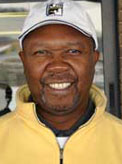 HOWARD BANKHEAD
HOWARD BANKHEAD
Blog: November 2011
DEVELOP STEM THROUGH GOLF
While reading an article written by Jesse Washington, AP National Writer in The Huntsville Times on Monday, October 24, 2011, edition on “Blacks Lag in ‘STEM’, I was propelled and encouraged to comment on how the lack of STEM affected me and countless numbers of my classmates in the late 1960’s when we attended W. C. Handy Elementary School and Burrell Slater Middle School in Florence, Alabama.
The STEM article is powerful. I encourage you to read this must read article. In this blog I will attempt to properly quote and use some of the passages from the article. I will use this article to explain and justify how my life experiences have influenced what I do today and how my 3-5-10 Initiative© will benefit and positively impact the lives of our youth.
STEM is the acronym for Science, Technology, Engineering and Mathematics. I remember in the 7th grade when most of my classmate failed math, which set them back a grade. Because they did not pass the math portion of the class, over half of my elementary classmates that would have graduated from high school in 1975, as I did, instead graduated in 1976.
We had a few that grasped the math and science concepts, and continued in their chosen careers; but the majority of my classmates back in the mid and late 1960’s, as are the majority of students today in 2011 in elementary and middle schools are not grasping higher-level math and science concepts. If there is no change, history will continue to repeat itself. As such, our goal should be to reshape history and lay out a new future for our young people.
As I continued to read the article, I felt a sense of anxiety because I could closely relate to the writer. The article reads, “…with black unemployment reaching historic levels, why aren’t more African-Americans looking toward science, technology, engineering and math. The answer turns out to be a complex equation of self-doubts, stereotypes, discouragement and economics and sometimes just wrong perceptions of what math and science is all about
The article continues: “…the percentage of African-Americans earning STEM degrees have fallen during the last decade. STEM barriers are not unique to black people. The United States does not produce as high a proportion of white engineers, scientists and mathematicians as it used to. Women and Latinos also lag behind white men. Yet the situation is most acute for African-Americans.”
Black people comprise 12 percent of the population and 11 percent of all students beyond high school. In 2009, they received just 7 percent of all STEM bachelor’s degrees, and 2 percent of Ph.D.s, according to the National Center for Education Statistics.
The numbers are striking in certain fields. In 2009, African-Americans received 1 percent of degrees in science technologies, and 4 percent of degrees in math and statistics. Out of 5,048 Ph.D.s awarded in the physical sciences, such as chemistry and physics, 89 went to African-Americans – less than 2 percent.
 Several factors are cited by scientists, educators and students. One is a self-defeating perception that STEM fields are too hard. Personally, this is what my classmates and I felt 40 years ago and it is disheartening to see that today’s students have the same problem. Point of personal privilege: I realize now why I do what I do in the field of youth development, because I don’t want kids of today to have this false sense of self-doubt and discouragement that many of my peers and I had.
Several factors are cited by scientists, educators and students. One is a self-defeating perception that STEM fields are too hard. Personally, this is what my classmates and I felt 40 years ago and it is disheartening to see that today’s students have the same problem. Point of personal privilege: I realize now why I do what I do in the field of youth development, because I don’t want kids of today to have this false sense of self-doubt and discouragement that many of my peers and I had.
Also mentioned is a lack of role models and mentors, pressure to earn money quickly, and a discouraging academic environment. Personally, I know from working in elementary and high schools that a large number of educators have low expectations of our students. When the opportunity presented itself, I would question the educator why they did not believe in their students?
The article goes on to say that the negative impact of STEM reaches beyond the black community as America struggles to produce enough scientists to prosper in a world ruled by technology. “White men make up less than 50 percent of the U.S. population. We’re drawing (future scientists) from less than 50 percent of the talent we have available,” says Mae Jemison, the first black female astronaut, who has a medical degree and a bachelor’s in chemical engineering.
“The more people you have in STEM,” she says, “the more innovations you’ll get.” Jemison, who was born in Decatur, Alabama, says the problem begins for children of all backgrounds in grade school, where they are usually asked to memorize facts out of a book instead of satisfying their natural curiosity through experiments and exploring. She also says many primary teachers took little science in college.
Point of reference: When you improvise in playing jazz you are experimenting, exploring and discovering. In my youth development life and golf programs, we employ the doing versus telling method so the students can experiment, explore and discover the golf experience.
Both the jazz and golfing processes are realized as a process in self-discovery. If implemented, the 3-5-10 Initiative© will allow for students to experience self-discovery and find themselves versus being totally influenced by pop-cultural and social media.
When I read this part of the article, I also realized how history repeats itself and there is nothing new under the sun. As Mae Jemison stated earlier and for my peers and I that failed and/or barely made it through math, all of our problems started in grade school. However my generation had special problems and situations…we were living through the end of the Jim Crow era, segregation and the beginning of integration in American life.
I personally can attest that the educational systems and institutions in place to develop me and my peers failed us! Just imagine how much stronger our world would be today if we all had equal opportunity and access.
Ironically, I must say that while the Jim Crow system and segregation infected the educational systems and institutions, black students had more pride in themselves and enthusiastically took on the challenges of learning how to read, write and conquer science and math. In those days, black teachers knew that they were responsible for and obligated to the black community for the development of the minds and character of black students.
They knew that the Jim Crow educational systems and institutions were unjust, but they did not use that as an excuse for failure. A sense of pride in the community and a strong work-ethic are what made my older brothers and sisters work hard to master their school work and they knew they had to do more than their white peers.
I can relate to the perception of self-doubt and discouragement because as a young person, I, too, thought that math and science were too hard to learn.
So in high school, I did just enough to get by, so I could stay on the football, basketball and track teams. I was a star athletic, a solid “C” student and class favorite. I attended Coffee High School in Florence, Alabama from 1971-75, a 13 percent black high school. I am one of a few students that got scholarships in two different sports, but, to this day, I regret not taking my class work more seriously. But, in spite of my lack-luster effort to get my school work done, I worked several jobs after school, after sports practice, and during the summertime.
One good thing about growing up in those days was our family and community insisted that if we wanted something we had to work for it. They built in us a strong work ethic. The 3-5-10 Initiative© presents the same values for our youth today. Our students will know that they have to work hard and smart to benefit from practicing their instrument and/or hitting the golf ball. Here, I insist on the students best efforts, giving their all in the process while in training and practice. This is called mastery!
After my sports career ended due to the death of my father in 1977, I knew it was time for me to take school more serious. After trying to “find myself” and transferring to and from several colleges, I settled down at Alabama State University in Montgomery, Alabama, where I obtain a Bachelor of Science degree in marketing in 1981. However, getting my degree wasn’t easy, because I didn’t get the math basics I needed in elementary, middle and high schools.
To make a long story short, when I was an advanced freshman at Alabama State, I declared business marketing as my major, I wasn’t aware that marketing was a quantitative field. I had to take college algebra and calculus; classes that I ran from in high school because of self-doubt and discouragement. I caught hell trying to pass those classes in college, but I am convinced that my work ethic and pride propelled me to not quit! I admit I had to take the courses over after I failed them, but failing then passing them prepared me to take on the more advanced marketing classes, such as management science, quantitative analysis, statistics, financial management and other math laden courses.
I have developed a golf and math curriculum. We use golf terms, rules and demonstrations to introduce the students to math, science and art. Part of the curriculum includes calculations, fractions, golf holes designs and golf course architecture. The kids use their imagination while they draw their golf holes and design their own golf course.
The 3-5-10 Initiative© is a long-range mentoring program that will help expose them to STEM education content.
Since 2002, over 2,700 students, ages 6-18, have benefited from Huntsville’s Tennessee Valley Youth Golf Development program (TVYGD). The 3-5-10 Initiative© is a new project of TVYGD. It addresses family structure and historical norms. TVYGD will take a leading role and partner with educational systems and institutions to tackle the negative effects of pop-culture. We know change is positive and anything positive is possible.
While it is not yet proven that kids will improve in STEM skills through the TVYGD 3-5-10 Initiative©, we do know from our work with 2,700 students that it makes learning math fun. In addition, we know from prior experience that introduction and continual programming in the life and golf skills program does build character.
About the Tennessee Valley Youth Golf Development:
Tennessee Valley Youth Development is a subsidiary of the Tennessee Valley Jazz Society-Huntsville, a 501(c)(3) nonprofit arts agency and youth development organization.
Founded in 1981, the Tennessee Valley Jazz Society mission is to “sponsor and encourage” artistic, sporting, health, and educational activities in the Tennessee Valley-metro Huntsville, Ala., area. Tennessee Valley Youth Golf Development (TVYGD) is a year-round grassroots structured program designed to introduce the sport of golf and the golf industry to school age students 7-18.
TVYGD is an educational program, which has received funding and support from the United States Golf Association (USGA) and the Professional Golfers Association (PGA). The educational programs include classroom studies, community field trips and player development, thus providing students the opportunity to obtain the knowledge and skills necessary to appreciate the game of golf. TVYGD culture is that golf is not only a fun recreational activity; it is also where character development and life skills are formed.
And I do believe!
Let me know your thoughts on this. Send me a message with your comments on my Youth Development Blog..
 Howard Bankhead
Howard Bankhead
Executive Director
Tennessee Valley Youth Golf Development
604 Jordan Lane
Huntsville, AL 35816 USA
256-604-8172



